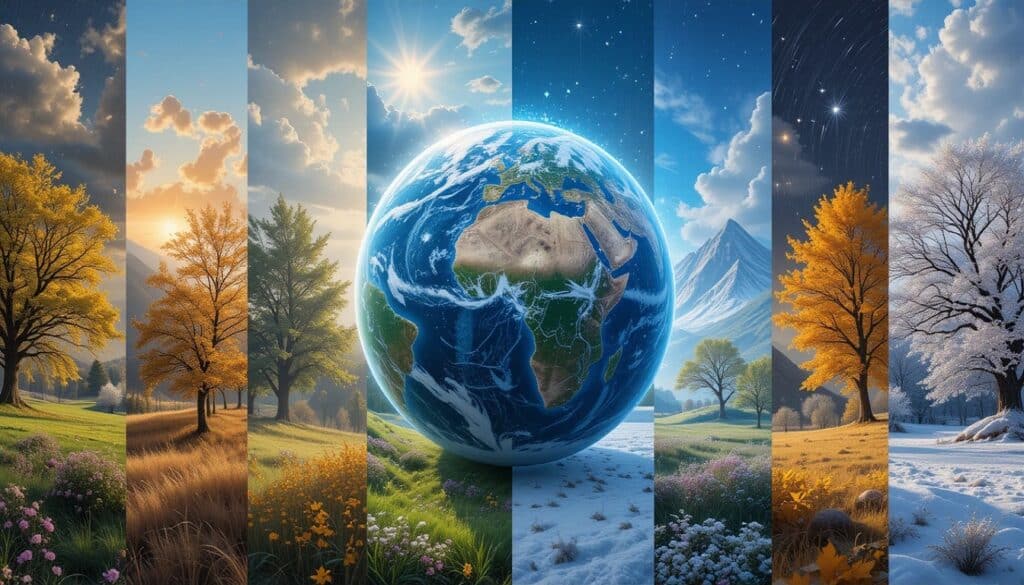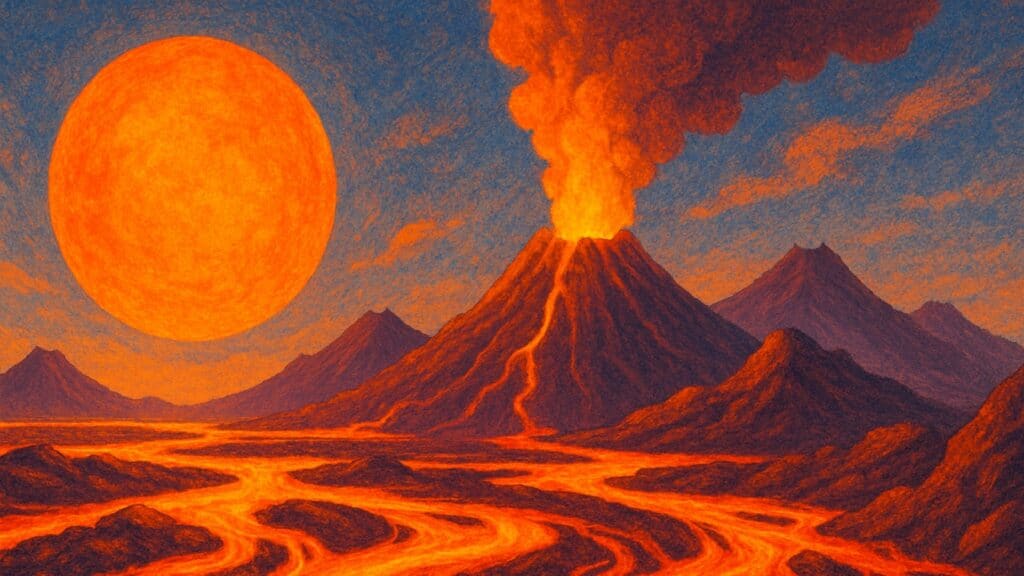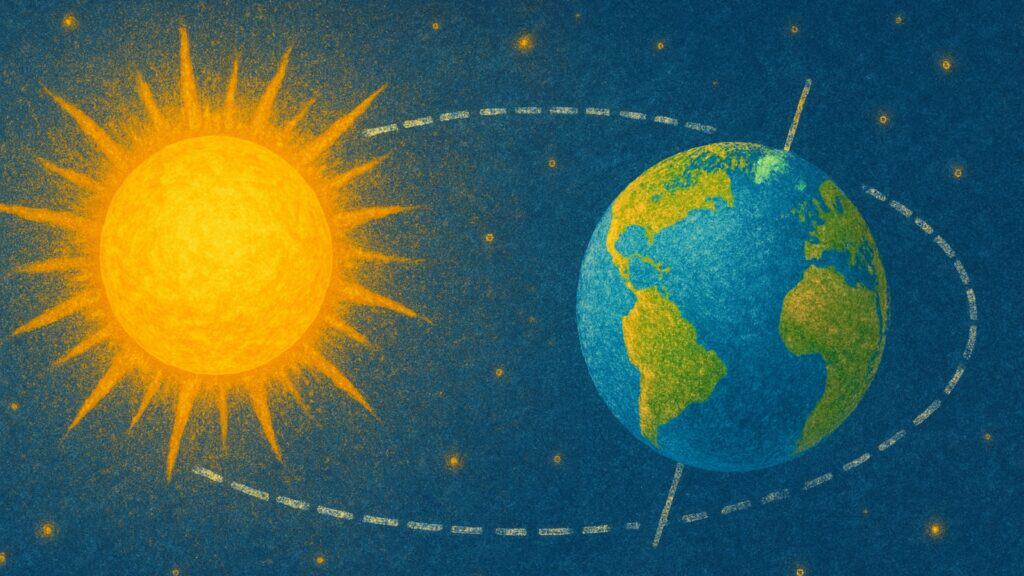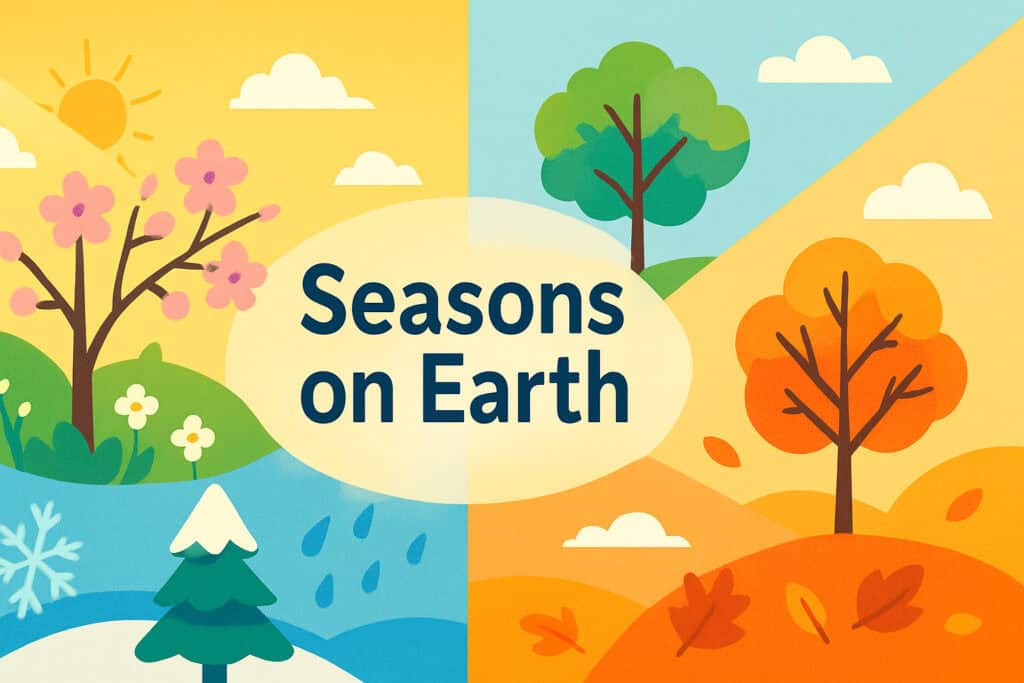Table of Contents
Introduction: Origins of Seasons On Earth — A Journey Through Deep Time

Seasons pulse through Earth like an ancient heartbeat, marking time across continents and shaping every living thing that calls this planet home. From the scorching summers that bake desert sands to the gentle spring rains that awaken sleeping seeds, these rhythmic changes have defined life’s possibilities for billions of years. Yet the seasons we know today emerged through an extraordinary journey that began when Earth itself was nothing more than cosmic dust swirling in the void.
The five major seasons that govern most of our planet tell stories of survival and adaptation. Summer brings intense heat and long days that fuel plant growth and animal activity. Monsoon drenches vast regions with life-giving water, transforming landscapes from brown to emerald green. Autumn paints leaves in brilliant colors before winter’s cold grip forces life into dormancy. Spring arrives like nature’s promise, awakening the world with warmth and new growth.
Beyond these familiar patterns, regional seasons reveal Earth’s incredible diversity. Tundra season in Arctic regions creates brief windows of life between endless nights. Pre-winter periods, known as Hemanta in South Asian regions, bridge the gap between monsoons and true winter. West Africa’s Harmattan brings dust-laden winds that transform entire regions. Wet climate across tropical zones creates distinct green periods that support millions of species.
This journey through deep time reveals how seasons transformed from impossible dreams on a molten world to the complex climate patterns that sustain modern civilization. Each era brought new forces that shaped these rhythms, from volcanic fury to orbital mechanics, from tiny microbes to human agriculture.
Table 1: Major Earth Seasons and Their Regional Variations
| Season Type | Primary Regions | Key Characteristics | Duration |
|---|---|---|---|
| Summer | Global (temperate zones) | High temperatures, long daylight hours | 3-4 months |
| Monsoon | South Asia, Southeast Asia | Heavy rainfall, wind reversal | 3-5 months |
| Autumn/Fall | Temperate regions worldwide | Cooling temperatures, leaf color changes | 2-3 months |
| Winter | Northern/Southern hemispheres | Cold temperatures, short days | 3-5 months |
| Spring | Temperate regions globally | Warming temperatures, plant growth | 2-3 months |
| Tundra Season | Arctic, Antarctica | Brief ice-free period, rapid plant growth | 1-3 months |
| Pre-Winter (Hemanta) | Indian subcontinent | Transition period, moderate temperatures | 1-2 months |
| Harmattan | West Africa | Dry, dusty winds from Sahara | 2-4 months |
| Wet Season | Tropical regions | High rainfall, lush vegetation | 4-8 months |
1. Seasons in the Hadean Eon: When Earth Was Too Young for Seasons

During Earth’s violent birth between 4.6 and 4.0 billion years ago, the very concept of seasons remained impossible. The Planetary Accretion Theory elucidates the process by which numerous rocky fragments collided under the unyielding force of gravity, resulting in the formation of our planet through cosmic impacts that produced extraordinary heat. The young Earth glowed like a forge, its surface molten and churning beneath skies that held no breathable air.
Temperatures across the planet’s surface reached thousands of degrees, hot enough to melt rock and vaporize any water that might have existed. No solid ground provided stability, no oceans offered thermal regulation, and no atmosphere created the pressure differences that drive weather patterns. The entire world existed in a state of perpetual inferno, where day and night meant nothing because the surface itself radiated heat like a small star.
Massive impacts from asteroids and proto-planets kept adding energy to this hellish system. The collision that likely formed our Moon occurred during this period, blasting enormous amounts of material into space and keeping Earth’s surface in a molten state for millions of additional years. Any climatic variation that might have developed from orbital mechanics disappeared beneath the overwhelming heat generated by continuous bombardment and radioactive decay.
Without water to absorb and redistribute heat, without land masses to create temperature contrasts, and without an atmosphere to carry energy around the globe, Earth remained locked in uniform hostility. The concept of seasons requires stable surface conditions, predictable energy inputs, and complex interactions between different parts of a planetary system. None of these existed during the Hadean Eon.
Table 2: Hadean Eon Conditions vs. Requirements for Seasons
| Earth System Component | Hadean Eon State | Requirements for Seasons | Status |
|---|---|---|---|
| Surface Temperature | 1,200-2,000°C molten rock | Stable, variable temperatures | Absent |
| Atmosphere | Minimal, hydrogen-helium | Dense, heat-redistributing gases | Absent |
| Water Bodies | Vaporized or absent | Oceans and lakes for thermal mass | Absent |
| Solid Land | Molten magma ocean | Continents for temperature contrast | Absent |
| Stable Orbit | Disrupted by large impacts | Predictable solar energy input | Disrupted |
| Day-Night Cycle | Overwhelmed by surface heat | Temperature variation driver | Ineffective |
2. The Birth of Water and Atmosphere: Foundations for Future Seasons

As Earth’s bombardment period gradually ended around 4.0 billion years ago, volcanic outgassing began creating the foundation for future climatic cycles. Massive eruptions released water vapor, carbon dioxide, nitrogen, and other gases from the planet’s interior, slowly building an atmosphere that could trap and redistribute heat. This process marked the first step toward conditions that might eventually support climatic variation.
Cometary impacts during the Late Heavy Bombardment brought additional water to Earth’s surface. As temperatures finally dropped below water’s boiling point, the first oceans began forming in low-lying areas. These early seas created the thermal mass necessary for climatic temperature variations, absorbing heat during warmer periods and releasing it slowly during cooler times.
The early atmosphere, though toxic to modern life, began creating the pressure gradients and wind patterns essential for weather systems. Carbon dioxide dominated this ancient air, creating a powerful greenhouse effect that helped maintain liquid water on the surface. Water vapor added another layer of heat retention while also enabling the first crude precipitation cycles.
Volcanic activity continued shaping both atmosphere and surface, but now these eruptions occurred on a solid crust rather than in a global magma ocean. Different regions began developing distinct characteristics as volcanic islands emerged and early continental masses started forming. This geographic diversity created the first opportunities for regional climate variation.
Ocean formation proved crucial for future weather development. Large bodies of water respond slowly to temperature changes, creating thermal inertia that moderates climate extremes. As these early seas grew larger and deeper, they began storing and releasing heat on periodic timescales, setting the stage for the stable climate cycles that would eventually support life.
Table 3: Early Atmospheric and Ocean Development
| Component | Formation Period | Composition/Characteristics | Impact on Future Climatic Cycle |
|---|---|---|---|
| Early Atmosphere | 4.0-3.8 billion years ago | 95% CO₂, water vapor, nitrogen | Created greenhouse effect, pressure gradients |
| First Oceans | 4.0-3.5 billion years ago | Acidic, high iron content | Provided thermal mass for heat storage |
| Volcanic Outgassing | 4.5-3.0 billion years ago | H₂O, CO₂, SO₂, N₂ | Built atmospheric density |
| Water Cycle | 3.8-3.5 billion years ago | Evaporation, condensation, rainfall | Enabled heat redistribution |
| Continental Crust | 4.0-2.5 billion years ago | Granite, early landmasses | Created land-sea temperature contrasts |
| Surface Pressure | 3.8 billion years ago | 10-100 times modern levels | Supported liquid water stability |
3. Seasons and the Stabilizing Earth: Oceans, Continents, and Early Climate Cycles

Between 3.8 and 2.5 billion years ago, Earth’s surface achieved the stability necessary for primitive climatic patterns to emerge. As the crust cooled and thickened, the first substantial continents rose above sea level, creating the land-ocean contrasts that drive many climatic phenomena. These early landmasses heated and cooled more rapidly than the surrounding oceans, generating temperature differences that powered the first recognizable weather patterns.
The growing oceans began developing circulation systems that moved heat from equatorial regions toward the poles. These currents created the first global heat distribution network, moderating temperature extremes and establishing the thermal gradients necessary for climatic variation. Warm equatorial waters flowing poleward and cold polar waters moving toward the equator began creating the oceanic conveyor belt that still influences modern climate.
Early continents, though smaller and less stable than modern landmasses, started influencing precipitation patterns. Mountain ranges formed by tectonic collisions created rain shadows and orographic effects that produced regional climate variations. Seasonal monsoons may have begun during this period as temperature differences between land and sea drove climatic wind reversals.
The first stable river systems appeared as continents grew larger and more permanent. These waterways began carving valleys and creating fertile plains where periodic flooding and drought cycles established rhythms that would later prove crucial for life’s evolution. Periodic changes in river flow patterns created diverse habitats and ecological niches.
The patterns of atmospheric circulation became increasingly intricate as the continents expanded in size and elevation. The interaction between land heating, ocean currents, and atmospheric dynamics began creating the first semi-permanent weather systems. High and low pressure zones started shifting periodically as the angle of solar radiation changed throughout Earth’s orbital cycle.
Table 4: Early Continental and Oceanic Climate Drivers
| Climate System | Development Period | Mechanism | Climatic Impact |
|---|---|---|---|
| Ocean Currents | 3.5-2.5 billion years ago | Thermal density differences | Heat redistribution between regions |
| Continental Formation | 3.8-2.5 billion years ago | Crustal cooling and thickening | Land-sea temperature contrasts |
| Mountain Building | 3.0-2.5 billion years ago | Tectonic collisions | Orographic precipitation patterns |
| River Systems | 3.2-2.0 billion years ago | Continental drainage networks | Periodic flood and drought cycles |
| Atmospheric Circulation | 3.0-2.0 billion years ago | Pressure gradient formation | Climatic wind pattern shifts |
| Thermal Zones | 3.5-2.0 billion years ago | Latitudinal temperature gradients | Proto-climatic temperature variation |
4. Seasons Under a Changing Sky: The Role of the Sun and Earth’s Tilt

Earth’s axial tilt of approximately 23.5 degrees creates the fundamental driver of climatic change, but this obliquity has varied significantly throughout geological time. Milankovitch Cycles describe how Earth’s orbital parameters change over thousands of years, influencing the intensity and timing of seasons across vast timescales. These astronomical factors began shaping climate patterns as soon as Earth developed a stable atmosphere and surface water.
The angle of Earth’s axis relative to its orbital plane determines how solar energy is distributed across different latitudes throughout the year. When the Northern Hemisphere tilts toward the Sun, it receives more direct radiation and experiences summer, while the Southern Hemisphere tilts away and experiences winter. This simple geometric relationship drives the periodic temperature changes that affect billions of lives.
Earth’s orbital eccentricity, which varies from nearly circular to moderately elliptical over 100,000-year cycles, influences the strength of climatic contrasts. When Earth’s orbit becomes more elliptical, the difference between closest and farthest approach to the Sun increases, intensifying climatic variations in one hemisphere while moderating them in the other.
The precession of Earth’s rotational axis, completing a full cycle every 26,000 years, slowly shifts the timing of seasons relative to Earth’s position in its orbit. This precession determines which season occurs when Earth passes closest to the Sun, affecting the relative intensity of summers and winters in both hemispheres over millennia.
Changes in axial tilt, varying between 22.1 and 24.5 degrees over 41,000-year cycles, directly influence climatic intensity. Greater tilts produce more extreme seasons with hotter summers and colder winters, while smaller tilts create milder climatic contrasts. These variations have driven major climate shifts throughout Earth’s history.
Table 5: Milankovitch Cycles and Climatic Influence
| Orbital Parameter | Cycle Length | Current Value | Range of Variation | Climatic Effect |
|---|---|---|---|---|
| Axial Tilt (Obliquity) | 41,000 years | 23.5° | 22.1° – 24.5° | Controls climatic intensity |
| Orbital Eccentricity | 100,000 years | 0.0167 | 0.000055 – 0.0679 | Affects climatic strength |
| Precession | 26,000 years | Variable | 360° rotation | Shifts climatic timing |
| Solar Distance (Aphelion) | Annual | 152.1 million km | ±3.4 million km | Modulates climatic energy |
| Solar Distance (Perihelion) | Annual | 147.1 million km | ±3.4 million km | Influences climatic contrasts |
| Day Length Variation | Annual | ±30 minutes | Latitude dependent | Drives photoperiod changes |
5. Seasons in the Age of Life: Photosynthesis, Oxygen, and Early Climate Feedbacks

The emergence of photosynthetic cyanobacteria around 3.5 billion years ago fundamentally transformed Earth’s weather patterns by introducing oxygen to the atmosphere and creating complex feedback loops between life and climate. These tiny organisms began converting sunlight and carbon dioxide into organic matter, establishing the first biological climatic cycles that still influence modern weather patterns.
Early photosynthetic life created climatic variations in atmospheric composition as microbial activity fluctuated with changing light and temperature conditions. During warmer months, increased photosynthesis removed more carbon dioxide from the atmosphere while releasing oxygen, affecting greenhouse gas concentrations and climate regulation. These biological processes introduced new variables into Earth’s seasonal equation.
The Great Oxidation Event between 2.4 and 2.1 billion years ago dramatically altered atmospheric chemistry and climatic behavior. Rising oxygen levels changed atmospheric dynamics, created new chemical reactions in the upper atmosphere, and established ozone formation that would eventually protect surface life from harmful solar radiation. These changes modified how solar energy interacted with Earth’s atmosphere during different seasons.
Seasonal blooms of early microorganisms began affecting ocean chemistry and circulation patterns. Mass photosynthetic activity during optimal growing seasons altered seawater pH, nutrient concentrations, and dissolved gas levels. These biological changes influenced ocean currents and heat distribution, adding biological components to purely physical climatic drivers.
The first ice ages, triggered partly by reduced atmospheric carbon dioxide from increased photosynthesis, created extreme climatic contrasts that shaped life’s evolutionary trajectory. Glacial and interglacial periods established new patterns of climatic intensity, with some regions experiencing permanently frozen conditions while others maintained year-round warmth.
Early ecosystems began developing climatic adaptation strategies that would become fundamental to life on Earth. Organisms evolved mechanisms to survive unfavorable seasons, store energy during productive periods, and time reproduction with optimal environmental conditions. These biological climatic cycles became integrated with physical climate patterns.
Table 6: Early Life Impacts on Climatic Systems
| Biological Process | Time Period | Atmospheric Effect | Climatic Consequence |
|---|---|---|---|
| Cyanobacteria Photosynthesis | 3.5-2.5 billion years ago | O₂ production, CO₂ reduction | Modified greenhouse effect |
| Great Oxidation Event | 2.4-2.1 billion years ago | 21% oxygen atmosphere | Changed atmospheric chemistry |
| Seasonal Algal Blooms | 2.0-1.5 billion years ago | Variable gas exchange | Ocean circulation changes |
| Carbon Burial | 2.5-1.5 billion years ago | Long-term CO₂ removal | Cooling climate trends |
| Methane Production | 3.8-2.0 billion years ago | Greenhouse gas addition | Enhanced seasonal warming |
| Ozone Layer Formation | 2.0-1.5 billion years ago | UV radiation filtering | Protected surface ecosystems |
6. Ice Ages and Shifting Seasons: How Earth’s Orbit and Axial Changes Reshaped Climate

The interplay between Milankovitch Cycles and Earth’s evolving climate system created dramatic shifts in climatic patterns throughout the past 2.6 million years. Major ice ages occurred when orbital configurations reduced summer solar radiation in northern latitudes, allowing winter snow and ice to persist year-round and gradually build massive continental glaciers.
During glacial periods, climatic contrasts became extreme in many regions while disappearing entirely in others. Areas covered by kilometer-thick ice sheets experienced permanent winter conditions, while regions just south of the ice margins dealt with dramatically shortened growing seasons and harsh winters that could last eight or nine months. These changes forced life to adapt or migrate to survive.
The advance and retreat of continental glaciers created entirely new climatic patterns across vast areas. As ice sheets grew, they reflected more solar radiation back to space, cooling global temperatures and extending winter conditions far beyond their physical boundaries. Climatic temperature ranges increased dramatically, with some regions experiencing winter temperatures 10-15 degrees Celsius below modern levels.
Ocean circulation patterns shifted dramatically during ice ages as massive freshwater inputs from melting glaciers disrupted normal current systems. The climatic timing of ocean heat transport changed, affecting climatic temperature patterns across entire continents. Some regions experienced delayed springs and early winters as oceanic heat sources weakened or shifted.
Interglacial periods brought rapid climatic changes as ice sheets retreated and ecosystems recolonized previously frozen landscapes. These warming periods created compressed growing seasons where thousands of years of ecological succession occurred within centuries. Climatic patterns had to reestablish themselves as climate zones shifted poleward.
The most recent ice age cycles demonstrate how orbital forcing creates predictable long-term changes in climatic intensity. Ice core records from Greenland and Antarctica reveal how climatic temperature and precipitation patterns varied throughout these cycles, providing detailed evidence of how astronomical factors influence Earth’s climatic behavior over geological time.
Table 7: Ice Age Impacts on Seasonal Patterns
| Time Period | Climate State | Climatic Characteristics | Geographic Impact |
|---|---|---|---|
| Last Glacial Maximum (20,000 years ago) | Full glacial | Extreme climatic contrasts | Ice sheets to 40°N latitude |
| Late Glacial Period (15,000-10,000 years ago) | Deglaciation | Rapidly changing climate | Massive ecosystem shifts |
| Holocene Optimum (9,000-5,000 years ago) | Interglacial warmth | Mild climatic contrasts | Expanded temperate zones |
| Little Ice Age (1300-1850 CE) | Minor cooling | Harsh winters, cool summers | Shortened growing seasons |
| Medieval Warm Period (900-1300 CE) | Regional warming | Extended growing seasons | Agricultural expansion |
| Modern Interglacial (Present) | Stable warm period | Moderate climatic patterns | Human-modified systems |
7. Human Civilization and the Seasons: Agriculture, Calendars, and Cultural Evolution

The development of agriculture around 10,000 years ago created an intimate relationship between human societies and climatic patterns that transformed both civilization and Earth’s landscape. Early farmers learned to read climatic signals, timing planting and harvesting with temperature changes, rainfall patterns, and daylight cycles that determined crop success or failure.
Ancient civilizations developed sophisticated calendar systems based on climatic observations, using astronomical events like solstices and equinoxes to mark important agricultural and religious periods. The Egyptian calendar aligned with Nile River floods, while Chinese agricultural calendars divided the year into 24 seasonal periods that guided farming activities with remarkable precision.
Seasonal festivals and cultural traditions emerged across human societies as communities celebrated successful harvests, marked the return of favorable growing conditions, or prepared for challenging winter months. These cultural adaptations to seasonal rhythms created social bonds and knowledge-sharing systems that helped communities survive unpredictable climatic variations.
Human agricultural practices began modifying local seasonal patterns through deforestation, irrigation, and land conversion. Clearing forests for farmland changed local temperature and precipitation patterns, while irrigation systems redistributed water across climatic cycles. These modifications created the first examples of human influence on seasonal climate patterns.
Trade networks developed around seasonal agricultural surpluses, with societies exchanging products that matured during different seasons or in different climate zones. Monsoon winds enabled seasonal trade routes across the Indian Ocean, while seasonal river flooding facilitated commerce along major waterways like the Nile and Yangtze.
The Industrial Revolution intensified human impact on seasonal systems through fossil fuel use, urbanization, and large-scale environmental modification. Factories and cities created heat islands that altered local seasonal temperature patterns, while coal burning began adding greenhouse gases that would eventually influence global climatic behavior.
Table 8: Human Adaptations to Climatic Patterns
| Civilization/Period | Climatic Adaptation | Agricultural Focus | Cultural Integration |
|---|---|---|---|
| Mesopotamian (8000 BCE) | Flood-season farming | Wheat, barley cultivation | Seasonal flood festivals |
| Egyptian (5000 BCE) | Nile flood calendar | Three-season agriculture | Religious seasonal cycles |
| Chinese (4000 BCE) | 24 seasonal periods | Rice, millet systems | Seasonal philosophy integration |
| Mayan (2000 BCE) | Astronomical calendars | Maize seasonal cycles | Seasonal ceremonial centers |
| Medieval European (1000 CE) | Seasonal labor patterns | Three-field crop rotation | Seasonal fair traditions |
| Industrial (1800 CE) | Urban seasonal adaptation | Mechanized agriculture | Seasonal migration patterns |
8. Modern Science and the Seasons: Understanding Weather, Climate, and Global Patterns

The modern comprehension of climate patterns is based on Earth System Science (ESS), which investigates the interactions among the atmosphere, hydrosphere, biosphere, and geosphere as interrelated elements of a complex planetary system. This holistic approach reveals how climatic changes result from intricate feedback loops between multiple Earth systems operating across various timescales.
Modern meteorology explains seasonal weather patterns through atmospheric dynamics, including jet stream behavior, pressure system migration, and air mass interactions that create predictable climatic changes in different regions. Advances in satellite technology and computer modeling now allow scientists to track climatic phenomena in real-time across the entire planet.
Ocean-atmosphere interactions play crucial roles in seasonal climate patterns, with phenomena like El Niño and La Niña demonstrating how oceanic changes can dramatically alter climatic behavior across vast regions. The Atlantic Meridional Overturning Circulation influences climatic temperature patterns throughout the North Atlantic, while monsoon systems depend on seasonal heating differences between land and ocean.
Climate change research reveals how human activities are modifying traditional climatic patterns through greenhouse gas emissions, land use changes, and urban development. Global warming is shifting climatic timing, intensity, and duration, with spring arriving earlier, growing seasons extending longer, and winter patterns becoming less predictable in many regions.
Ecosystem studies show how climatic changes influence biodiversity, migration patterns, and ecological relationships across multiple scales. Phenology research tracks how climate change affects climatic timing of biological events like flowering, breeding, and migration, revealing disruptions to ecological synchronization that evolved over millions of years.
Advanced climate models now incorporate seasonal variations in their projections of future climate change, helping scientists understand how global warming will affect climatic patterns in different regions. These models consider interactions between changing orbital cycles, greenhouse gas concentrations, and Earth system feedbacks to predict seasonal climate evolution.
Table 9: Modern Scientific Understanding of Climatic Mechanisms
| Scientific Field | Key Discoveries | Climatic Applications | Future Research Directions |
|---|---|---|---|
| Atmospheric Physics | Jet stream dynamics | Climatic weather prediction | Climate change impacts |
| Oceanography | Thermohaline circulation | Climatic current variations | Ocean warming effects |
| Ecology | Phenological timing | Species adaptation patterns | Ecosystem disruption risks |
| Climatology | Greenhouse gas effects | Climatic warming trends | Regional climate projections |
| Remote Sensing | Global observation systems | Real-time seasonal monitoring | Improved prediction models |
| Computer Modeling | Complex system interactions | Seasonal climate forecasting | Enhanced resolution capabilities |
Conclusion: Seasons in the Present and Future — Climate Change and the Road Ahead

The remarkable journey of seasons from impossible dream to planetary reality spans 4.6 billion years of Earth’s evolution, revealing how astronomical, geological, and biological forces combined to create the rhythmic patterns that sustain modern life. From the molten chaos of the Hadean Eon to today’s complex seasonal systems, seasons have evolved through countless transformations that shaped every aspect of our planet’s development.
Today’s climatic patterns face unprecedented challenges as human activities alter atmospheric composition, ocean chemistry, and global temperature distributions. Climate change is shifting seasonal timing, with spring arriving weeks earlier in many northern regions while growing seasons extend into traditional winter months. These changes ripple through ecosystems, agricultural systems, and human societies that evolved around predictable climatic rhythms.
Research indicates that climatic temperature contrasts may weaken in some regions while intensifying in others as global warming continues. Tropical zones may experience expanded wet and dry seasons, while polar regions face reduced seasonal ice formation and accelerated melting periods. These shifts will require massive adaptations across both natural and human systems.
Future climatic patterns will depend on humanity’s response to climate change challenges. Reducing greenhouse gas emissions could help preserve climatic stability, while continued fossil fuel use may create unprecedented climatic extremes that exceed many species’ adaptive capabilities. The choices made in coming decades will determine whether seasons remain reliable guides for natural cycles or become increasingly unpredictable forces.
Understanding climatic evolution provides crucial insights for addressing climate challenges and planning sustainable futures. The deep time perspective reveals both the resilience and fragility of Earth’s seasonal systems, offering hope that thoughtful stewardship might preserve these ancient rhythms for future generations while adapting to necessary changes.
Table 10: Climate Change Impacts on Future Seasonal Patterns
| Seasonal Aspect | Current Trends | Projected Changes (2050) | Adaptation Requirements |
|---|---|---|---|
| Spring Timing | 2-3 weeks earlier | 4-6 weeks earlier | Agricultural calendar shifts |
| Growing Season Length | 10-14 days longer | 20-30 days longer | Crop variety adaptations |
| Winter Temperature | 2-4°C warmer | 3-6°C warmer | Ecosystem range shifts |
| Precipitation Patterns | More extreme events | Intensified variability | Water management changes |
| Seasonal Migration | Timing disruptions | Route modifications | Conservation strategy updates |
| Human Health | Heat stress increases | Extended allergy seasons | Public health adaptations |
Read More Science and Space Related Articles
- 8 Amazing Ways Scuppernong Enriched Southern US Music
- Catawba Grape: 8 Stunning Secrets Behind Its Chemistry
- 8 Amazing Ways Concord Grapes Sustain Native Biodiversity
- 8 Amazing Ways Cosmic Inflation May Have Forged Multiverse
- 6 Weird Truths About Space Time That You May Not Know
- Quantum Fluctuations: 8 Inspiring Lessons on Transience




